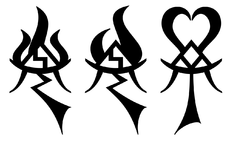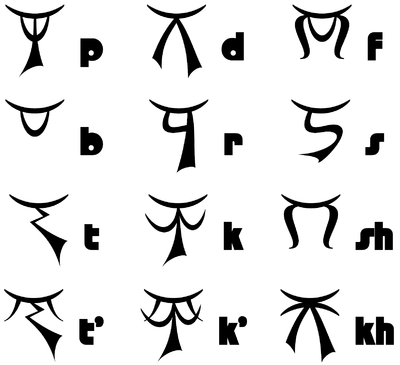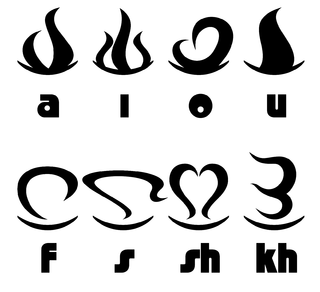Appendix:Ts'íts'àsh orthography: Difference between revisions
No edit summary |
No edit summary |
||
| (11 intermediate revisions by the same user not shown) | |||
| Line 1: | Line 1: | ||
The [[Ts'íts'àsh language]] from {{wl|Disney}} and {{wl|Pixar}}'s ''[[Elemental]]'' is written using an {{wl| | {{LangBar|Ts'íts'àsh|Ts'íts'àsh dialogue}} | ||
The [[Ts'íts'àsh language]] from {{wl|Disney}} and {{wl|Pixar}}'s ''[[Elemental]]'' is written using an {{wl|alphasyllabary}} created by [[David J. Peterson]] and [[Jessie Peterson]]. | |||
==Orthography== | ==Orthography== | ||
Ts'íts'àsh is written with | Ts'íts'àsh is written with an {{wl|alphasyllabary}}, that is, an {{wl|abugida}}, a script which represents syllables, including their onset (consonant), nucleus (vowel or consonant), and optional coda (consonant), as single, combined glyphs. The script could also be described as consisting of base onset consonant glyphs which are modified in predictable ways to indicate the quality of the following nucleus and, optionally, a coda. This means that glyphs in the script with common phonetic elements share graphical similarities. An important difference from many abugidas, however, is that the basic unmodified onset consonant elements do not have an inherent nucleus that is pronounced. | ||
The orthography appears to be somewhat historical, meaning that older phonetic elements of the language that have since changed pronunciation are represented in the orthography. Consequently, there is not always a one-to-one correspondence between the graphical elements of the written form and the phonetic elements of the spoken form. | The orthography appears to be somewhat historical, meaning that older phonetic elements of the language that have since changed pronunciation are represented in the orthography. Consequently, there is not always a one-to-one correspondence between the graphical elements of the written form and the phonetic elements of the spoken form. | ||
=== | ===Glyphs=== | ||
The Ts'íts'àsh | The Ts'íts'àsh glyph starts with the onset, called the "fuel" or {{m|tsit|àkh}} (red in the image below), at the bottom. Above it there is the "pan" or {{m|tsit|dàr}} (green in the image below), a slightly curved horizontal element, which separates the onset from the nucleus. Above that there is the nucleus represented by the "result" or {{m|tsit|róshà}} (blue in the image below): | ||
[[File:ts3.png|80px]] | [[File:ts3.png|80px]] | ||
In many syllabograms there is an angular element between the "pan" and the "result" which | In many syllabograms there is an angular graphical element between the "pan" and the "result" which can represent various phonetic elements. In such cases, the "result" can represent a coda consonant. Not much is known about this graphical element. Examples of this are seen in the spelling of the name of the language, {{m|tsit|Ts'íts'àsh}}: | ||
[[File:ts4.png|230px]] | [[File:ts4.png|230px]] | ||
| Line 25: | Line 27: | ||
[[File:ts2.png|320px]] | [[File:ts2.png|320px]] | ||
[[Category:Ts'íts'àsh language|Orthography]][[Category:Script appendices]] | ==See also== | ||
* https://dedalvs.com/work/elemental/misc/tsitsash_writing_system.pdf | |||
[[Category:Ts'íts'àsh language|Orthography]] | |||
[[Category:Ts'íts'àsh appendices|Orthography]] | |||
[[Category:Ts'íts'àsh script| ]] | |||
[[Category:Script appendices]] | |||
Latest revision as of 08:19, 21 January 2024
The Ts'íts'àsh language from Disney and Pixar's Elemental is written using an alphasyllabary created by David J. Peterson and Jessie Peterson.
Orthography
Ts'íts'àsh is written with an alphasyllabary, that is, an abugida, a script which represents syllables, including their onset (consonant), nucleus (vowel or consonant), and optional coda (consonant), as single, combined glyphs. The script could also be described as consisting of base onset consonant glyphs which are modified in predictable ways to indicate the quality of the following nucleus and, optionally, a coda. This means that glyphs in the script with common phonetic elements share graphical similarities. An important difference from many abugidas, however, is that the basic unmodified onset consonant elements do not have an inherent nucleus that is pronounced.
The orthography appears to be somewhat historical, meaning that older phonetic elements of the language that have since changed pronunciation are represented in the orthography. Consequently, there is not always a one-to-one correspondence between the graphical elements of the written form and the phonetic elements of the spoken form.
Glyphs
The Ts'íts'àsh glyph starts with the onset, called the "fuel" or àkh (red in the image below), at the bottom. Above it there is the "pan" or dàr (green in the image below), a slightly curved horizontal element, which separates the onset from the nucleus. Above that there is the nucleus represented by the "result" or róshà (blue in the image below):
In many syllabograms there is an angular graphical element between the "pan" and the "result" which can represent various phonetic elements. In such cases, the "result" can represent a coda consonant. Not much is known about this graphical element. Examples of this are seen in the spelling of the name of the language, Ts'íts'àsh:



